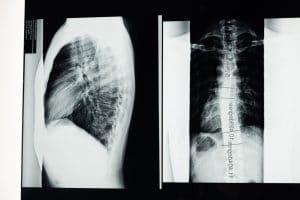No Obligation
Free Consultation

The sacroiliac (SI) joints are formed by the connection of the sacrum and the right and left iliac bones. The sacrum is the triangular-shaped bone in the lower portion of the spine, centrally located below the lumbar spine. While most of the bones (vertebrae) of the spine are mobile, the sacrum is made up of five vertebrae that are fused together and do not move. The iliac bones are the two large bones that make up the pelvis. As a result, the SI joints connect the spine to the pelvis. The sacrum and the iliac bones (ileum) are held together by a collection of strong ligaments.
Dysfunction in the sacroiliac joint can sometimes cause lower back and/or leg pain. Leg pain from sacroiliac joint dysfunction can be particularly difficult to differentiate from radiating leg pain caused by a lumbar disc herniation (sciatica) as they can feel quite similar. For decades, the sacroiliac joint was suspected as a common cause of low back and/or leg pain, although difficulty in accurate diagnostic testing left many in the medical profession skeptical. Today it is estimated that the sacroiliac joint is responsible for 15% to 30% of lower back pain cases.
Symptoms Experienced With Sacroiliac Joint Dysfunction
- Lower back pain that feels dull, aching, and can range from mild to severe. Lower back pain is typically felt only on one side, but in some cases may be felt on both sides. See Lower Back Pain Symptoms
- Pain that spreads to the hips, buttocks, and/or groin. One of the most common areas to feel SI joint pain is in the buttocks and upper back or side of the thigh. Pain is typically felt only on one side but may be felt on both sides.
- Sciatic-like pain in the buttocks and/or backs of the thighs that feels hot, sharp, and stabbing and may include numbness and tingling. Sacroiliac joint dysfunction may cause sciatica-like symptoms that rarely extend below the knee.
- Stiffness and reduced range-of-motion in the lower back, hips, pelvis, and groin, which may cause difficulty with movements such as walking up stairs or bending at the waist.
- Worsened pain when putting added pressure on the sacroiliac joint, such as climbing stairs, running or jogging, and lying or putting weight on one side.
- Instability in the pelvis and/or lower back, which may cause the pelvis to feel like it will buckle or give way when standing, walking, or moving from standing to sitting.
REQUEST A FREE CONSULTATION
We’ll provide a free investigation into the details of your case and the options you may have available.
There Are Several Orthopedic Provocation Tests That Can Rule Out Or Identify The Sacroiliac Joint As The Pain Source, Including:
- Sacral thrust test, in which pressure is applied to the back of the hips while lying face down (prone) on an examination table. The sacral thrust test is considered positive when this pressure reproduces pain.
- Distraction test, in which pressure is applied to the front of the hips while lying face up (supine). A positive test occurs when pressure applied to the hips reproduces pain.
- FABER test, in which while lying on the back, one leg is kept straight while the other foot touches the inside of the straight knee. Pressure is applied to the SI joint by gently pushing the bent knee down and out. Modifications to this test can include pulling the bent knee straight up toward the chest, and/or moving it from side-to-side. Downward pressure may also be applied to the opposite hip. The FABER test is considered positive if these movements reproduce pain or cannot be completed due to limited range-of-motion. This test can reproduce pain in the hip, lower lumbar region, and/or the SI joint and pin-pointing the pain location is important before concluding this test as positive for SI joint pain.
- Palpation tests, in which deep thumb pressure is applied directly over the entire SI joint on each side. A positive test is tenderness over the affected SI joint, which should then be correlated with other provocative tests. When several types of motion palpation tests are included with clusters of provocative tests such as those described above, the highest level of accuracy was found.
As noted above, the sacroiliac joint is confirmed as the pain source if a combination of movement tests reproduces a similar pain response over the involved SI joint and, other causes have been ruled out.
Traumatic injury such as a sudden impact, such as a motor vehicle accident or a fall, can damage your sacroiliac joints. The Ledezma Law Firm handled many cases in the past where our clients hurt their sacroiliac joints. In both cases, the passengers were seated in the front passenger seat of a vehicle and when impact occurred their feet were pressed on the floor so hard that there was undue pressure on the SI joints. This undue pressure caused damage to the SI joints. Magnetic resonance imaging (MRI) is not very good at diagnosing this type of injury. As discussed above, special testing must be done to properly diagnose this injury.
REQUEST A FREE CONSULTATION
We’ll provide a free investigation into the details of your case and the options you may have available.
If therapy is not resolving the pain then injections and at times surgery is needed. The two types of surgery are as follows:
- Minimally invasive surgery. Most SI joint fusion surgeries are this kind. The surgeon makes small cuts in your buttocks and uses X-ray scans to see where to go with the surgical tools. Then they drill holes in the sacrum and ilium and puts in implants to make the joint more stable.
- Open surgery. In this type of operation, the surgeon makes a cut about 7 or 8 inches long and opens up your muscle and tissues to get to the SI joint. They remove tissue called cartilage from between the sacrum and the ilium. The surgeon usually takes a piece of bone from your pelvis, called a bone graft, and puts it into the joint. They will also put a few screws in the joint to hold it together while it heals. Eventually, the bone graft turns into bone and the joint is fused together.
SI joint injuries require an attorney with extensive knowledge of the anatomy of the joint and the ability to demonstrate the seriousness of the injury to insurance companies and juries. As such, it is important to hire an attorney that has experience handling SI joint injury cases.
Contact us for a free consultation at (561)454-9727. You will pay us nothing unless we make a recovery for you.




